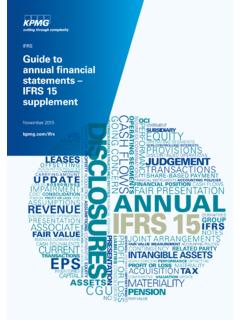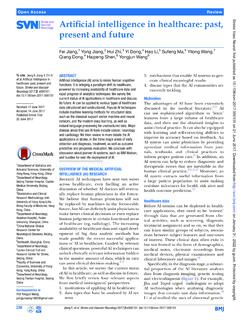Transcription of Robotic Process Automation (RPA) - KPMG
1 2018 KPMG Consulting Co., Ltd., a company established under the Japan Company Law and a member firm of the KPMG network of independent member firms affiliated with KPMG International Cooperative ( KPMG International ), a Swiss entity. All rights office workRobotic Process Automation (RPA)On Entering an Age of Automation of White-collar Work Through Advances in AI and RoboticsRecent progress in digitization has had significant impact on white-collar work as well as on products and their related technology. It has been said that in the next 10 to 20 years, 47% of jobs will be substituted by automated or robot labor. RPA is a particular type of digitization, and its implementation is absolutely essential to raising a company s added value in the future. At KPMG, we assist corporate problem-solving through our support for RPA implementation, making use of our prodigious industry knowledge of business innovation and RPA implementation cases in both Japan and Is RPA and Digital Labor?
2 Sales-relatedClerical Work Entering customer information Name identification processingAccounting & Finance Invoice processing Expenses processing Cashflow statement creationPayroll & Benefits Personnel data correction Year-end tax adjustmentApplication Processing Filling in application forms data deficiency checkingTargetIncreased Efficiency330-75% dropIncreased Quality1 Eliminating human errorsIncreased Functionality4 Focus on workwith greater added valueSpeed2 Improve processing speed by several hundred timesEffect Strong AI/Autonomous AI Major Applicable Tasks data collection (crawling) data query (structured data ) data entry Validation Logins to multiple systems, Automates even routine tasks that were performed by human labor due to whatever constraints applied, using business rules engine, image recognition technology, workflow, and so on. Human labor is needed to deal with situations such as exception cases, though.
3 data query (unstructured data ) Answer queries utilizing knowledge base (knowledge DB, massive data source) analytics provided through human intervention, etc. Creating rules from aggregated past data Automation of exception case processing and non-routine tasks Learning based on data analysis(Deep learning) Unstructured data processing (ex. natural languages) data Analysis&UnstructuredInformation Processing Decision-making Complex processing Advanced analytics , etc. Advanced AI enables Automation of Process analysis, improvement, and decision-makingabove and beyond work (Conceptual) Mega macro with the power to freely perform inter-system processing Cognitive AI Business Rules EngineWorkflowImage RecognitionLarge-scale processingAutonomous adaptationNatural language processingBig data analysisAIMachine learningAutomation of Routine WorkClass 1 Automation of Some Non-routine WorkClass 2 Advanced AutonomizationClass 3 The Scope of This DocumentOverview of the RPAWhat Is RPA and Digital Labor?
4 RPA comprises distinct types: Automation of routine office work and Automation of advanced intelligent processes through means such as artificial intelligence (AI). The effectiveness of routine office work Automation has been operationally validated in not only North America and Europe but also in Japan, and this type of Automation is now in practical can be described as introducing digital labor (digital worker) into the corporate organization in order to carry out work that only human labor was formerly considered capable of doing, or to augment human labor in carrying out highly advanced Classes and Major Scopes of ApplicationThere are three classes in RPA, and at the present, companies are starting to create sizable impact through Class 1 are projected to reach Class 3 in five years, able to automate Process analysis, improvement, and decision-making. 2018 KPMG Consulting Co., Ltd., a company established under the Japan Company Law and a member firm of the KPMG network of independent member firms affiliated with KPMG International Cooperative ( KPMG International ), a Swiss entity.
5 All rights RPA, Why Now?Surge in Labor Cost in Developing Nationsand Evolution of Digital TechnologySince the 1990s, an increasing number of firms have sought to reduce their operating cost by outsourcing some of their white-collar work to developing countries with lower cost of labor, such as China and India. However, recent years have seen an upsurge in labor cost in developing countries, making it more difficult to reduce costs by leveraging labor cost differentials. The troubling rate of worker turnover in developing nations poses an additional challenge to securing sufficient level of the other hand, technological development has resulted in greater Automation in some industries such as the automotive sector, where the scope of Automation has already been expanded for practical use. Automation of white-collar work through RPA, using technologies such as AI and robotics, is now poised for Impact of RPA implementationContribution to Quality ImprovementRPA enjoys high affinity with clerical task processing in general, and compared to human labor, is more capable of carrying out tasks both continuously and reliably.
6 Consequently, errors and clerical mistakes are greatly reduced, leading to improved task to SpeedData editing, screen operation, and other tasks via RPA do not involve physical manipulation of devices such as keyboard and mouse, and therefore a task can be accomplished at tens and hundreds of times the speed of human labor, resulting in overwhelming increase in speed of operation. In addition, the speed of implementation and response to changes, and overall speed in producing results, will also to Efficiency ImprovementRPA renders human intervention superfluous; work can be carried out in parallel with virtually no resource constraints. The result is that while cost-reduction achieved through business Process outsourcing (BPO) and other measures based on labor cost differentials and standardization is thought to top out at 15-30 %, RPA enables cost reduction of 40-70 %.** According to results for Company A in their final Thought to Have the Largest ImpactResponseRate1 Decrease in error rate21%(1)Improved Quality2 Improved quality of routine tasks21%(1)Improved Quality3 Improved speed of business Process implementation19%(2)Speed4 Reduced dependency on multiple systems and screens14%(3)Improved Efficiency5 Increase in STP (straight through processing)11 %(3)Improved Efficiency6 Accumulation of data for Process improvement7%(4)Improved Functionality7 Potential reduction of excess tasks7%(4)Improved FunctionalityImproved Quality Capable of more continuous, reliable, and high-quality task implementation than human Functionality (Shift Towards Business with Greater Added Value) Humans are freed from routine work, able to engage instead in work with high added value.
7 One incidental effect is that various historic data can be amassed, contributing to identification of further opportunities for Efficiency Because a large number of tasks are automated, work can be carried out in parallel with virtually no resource Overwhelmingly greater speed of implementation and response to changes, speed in producing results, and speed of : Customer Feedback from Early Adopters of RPAThe efficiency of our processes improved due to RPA implementation, leading to improved quality while also enabling us to focus more resources on work with greater added value such as improving the Process itself or generating : Insights from Early BPO Adopters of Robotic ProcessAutomation, Horses for Sources,February of Study on Effects of RPA ImplementationGoals & Effects of RPA Implementation 2018 KPMG Consulting Co., Ltd., a company established under the Japan Company Law and a member firm of the KPMG network of independent member firms affiliated with KPMG International Cooperative ( KPMG International ), a Swiss entity.
8 All rights implementation has the potential to change the way processes and business are done. Greater effectiveness can be unleashed by incorporating business Process reform into the perspective rather than simply viewing the matter as RPA tool SpecificationEffect AchievedRPA Building Process123 Risks & ChallengesResolution through Development Standards Leveling of granularity in RPA creation Increase maintainabilityCompliance risk due to absence of activity trailDecline in ROI due to pursuit of perfect automationRisk of work stoppage due to unstable performanceErratic quality and serviceability due to architecture that increasingly depends on individual skills Linkage with subsequent work Detection of any abnormalities that occur Avoidance of security risk Recording and storage of results from logging activity (audit trail) 4132 Operational Stability MaintenanceEffectiveness & Quality AssuranceComplianceBuilding Operation Management FunctionsSix different aspects of RPA operation management architecture must be considered during the post-PoC, implementation launch and standardization phase.
9 * The following six perspectives are RPA-TOM (Target Operating Model), a KPMG s consulting & GovernanceTechnologyPerformance Securing personnel who will be responsible for operation management functions and developing their skills. The scope of outsourcing to third parties in operation management. Implementation, operation and management processes and functions needed to achieve maximum effect in a stable manner. Effectiveness evaluation indices for each operation management function. IT tools and platform for efficiently achieving operation management functions. Organizational makeup and role assignment for achieving operation management & SkillsPersonnel & SkillsProcessOrganization& GovernanceTechnologyPerformanceOutsourci ngRPAO peration & ManagementBuilding and Operating RPAKPMG s RPA development and quality standards distill best practices nurtured through a wealth of productive experience to successfully build efficient and high-quality RPA that leverages the characteristics of RPA tools.
10 Technology verification and vendor selection Applicability testing ROI estimatePoC2 Work analysis & selection, requirements specification RPA design, building, implementation, version upgrade Release, operation, maintenance, response to inquiriesBuilding and Promoting RPA Operations6 Formulation & implementation of RPA rollout plan ROI analysis and assessmentFuture Plans1 Design, building, implementation, and testing of RPA implementation & operation processes, rules and organizational structure Building of RPA integrated monitoring infrastructureBuilding Operation Management Functions5 Large-scale RPA management strategy & horizontal deployment policy drafting/implementation Robot analysis and assessment (KPI) system design/promotionUpgrading OperationManagement Functions8 Regularization of PDCA cycle Operational transformation utilizing RPAM onitoring & Improvement9 RPA program scope, schedule, risk, and resource management Integrated change management such as impact survey and regularization of various activities involved in RPA implementationProgram & Project Management4 Formulation of RPA management organization & system Cultivation of personnel to launch RPA implementationPreparing to Launch theRPA Organization3 Cultivation of personnel for development and operation work.















